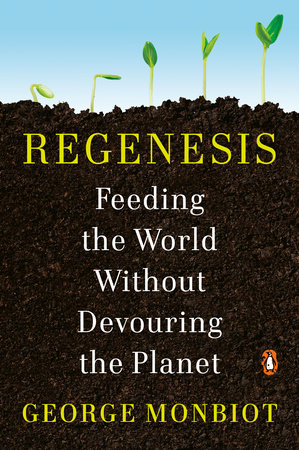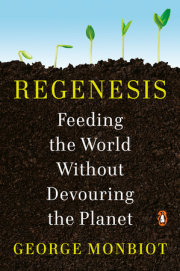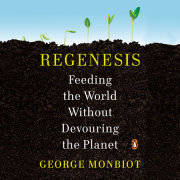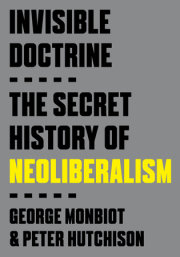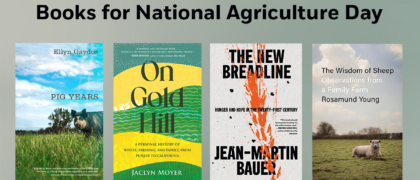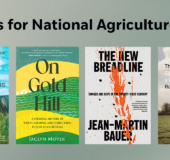1
What Lies Beneath
It's a wonderful place for an orchard, but a terrible place for growing fruit. In central England, far from the buffering effect of the sea, the trees are blighted by late frosts. Freezing air flows like water, but here, on this flat plot, dammed by rows of houses, it gathers and pools, drowning the orchard in cold.
Every year, as the trees come into blossom, my hopes crack open with the breaking buds. Roughly two years out of three, they wither with the flowers. Frost curls into the branches like poison gas, shrivelling and blackening the stamens.
By autumn, the orchard is a living graph of spring temperatures. Apple varieties blossom at different but regular dates. Unless a freeze is especially hard, it damages only the open flower. From the trees with and without fruit, you can tell when the frost struck, almost to the night.
Every variety belongs to the same species: Malus domestica, which translates literally as tamed evil. The reasons for the age-old defamation of a lovely tree are complex, but one is likely to be etymological confusion: a dialect name for fruit-, or "malon"-appears to have slipped from Greek into Latin, where it was, so to speak, corrupted: into malum, or evil.
This single species, too good to be true, has been bred into thousands of different forms: dessert apples, cooking apples, cider apples, drying apples, in an astonishing range of sizes, shapes, colors, scents, and flavors. We grow Miller's Seedling, which ripens in August and must be eaten from the tree, as the slightest jolt in transit bruises its translucent skin. It is sweet and soft, more juice than flesh. By contrast, the Wyken Pippin, hard as wood when picked, is scarcely edible till January, then stays crisp until the following May. We grow St. Edmund's Pippin, which has skin like sandpaper and is dry and nutty and aromatic for two weeks in September, after which it turns to fluff, and the Golden Russet, whose taste and texture are almost identical, but only in February. The Ashmead's Kernel, crunchy, with a hint of carraway, my favorite apple, peaks in midwinter. The Reverend W. Wilks puffs up like wool when you bake it, and tastes like a smooth white wine. The Catshead, roasted at Christmas, is almost indistinguishable from mango puree. Ribston Pippin, Mannington's Pearmain, Kingston Black, Cottenham Seedling, D'Arcy Spice, Belle de Boskoop, Ellis Bitter: these fruit are capsules of time and place, culture and nature.
As every tree requires subtly different conditions to prosper, some do better here than others. Some varieties are so finely adapted to their place of origin that they perform disappointingly on the other side of the same hill. By choosing breeds that blossom at different times, we have sought in this orchard to spread the risk. Even so, in bad years, when frost strikes repeatedly, we lose almost everything.
But yes, despite the many broken dreams, it's a wonderful place for an orchard. When I arrived this morning, its beauty made me gasp. The first apple trees have come into flower: the pink buds uncurling to reveal their pale hearts. The pear and cherry trees are in full sail, carrying so much white blossom that their branches lift slightly in the breeze.
I walk the rows of trees, smelling them. Every variety has a different, faint scent: some of the blooms smell like hyacinth, some like lilac, some like Daphne or viburnum. I believe I can tell when a flower has been pollinated: the perfume, no longer needed to attract bees and hoverflies, is immediately cut off. The pear blossom, pure white, with twenty black stamens like tiny cloven hooves, stinks revoltingly of anchovies. The cherry petals are beginning to flake from the trees, drifting and feathering in the light wind. The new grass is streaked with shadow. Wood pigeons growl in the plum trees. To have all this within a few hundred meters of our home feels like an astonishing luxury; a luxury for which, between the five families who share it, we pay just £75 a year.
The orchard occupies three adjoining plots on an allotment site. Since 1878 in England, local governments have allotted land for people to cultivate vegetables and fruit. In principle, since 1908, we have all had the legal right to grow.
What this legislation inadvertently spread was anarchy, in its true sense. In other words, it created thousands of self-organized, self-governing communities, otherwise known as commons. Though the local government owns the land, it is managed and run by the people who work it. Our site in Oxford is divided into 220 plots, cultivated by people who have arrived in the city from all over the world. We cross-pollinate each other's knowledge with grains of peculiar experience.
Seventeen years ago, the allotments seemed to be dying. Only one-tenth of the plots were occupied. The remnant community was desperate for people to take them on: otherwise, the local authority would reclaim the site for housing. They leased me two and a half adjoining plots, one of which was covered in monstrous brambles, snaking three meters into the air. I spent a month cutting the stems with a bush knife and hacking out the rootballs with a mattock. Beneath them sleeping beauty lay. Meadow grasses, cowslips, oxeye daisy, germander speedwell, vetch, knapweed, wood avens, scabious, yarrow, ribwort plantain, cat's ear, and hawkbit sprang from the soil. The seeds must have lain dormant for decades. I persuaded a couple of friends to join me, and we planted the plots with heritage fruit trees: mostly apples, with a few plums, cherries, and pears, a medlar and a quince.
Just as the trees became productive, I left Oxford and moved to Wales. Abandoning the orchard was among my few regrets. My friends passed it to others, who in turn passed it on. Five years later, unexpectedly, for family reasons, I returned. I didn't want to be back. But soon after I arrived, one of my best friends in the city told me that some people who had recently moved away had passed him a beautiful orchard, planted on the allotments a few years before. . . . He couldn't manage it alone, and remembered that I knew something about fruit trees.
It felt like coming home.
Now, though it covers less than one-tenth of a hectare, the orchard sometimes feels like half my world. It is the living calendar that marks my year. We have brought in three other families, creating a miniature commons within a commons. Every couple of months, we organize a work day, with a break for lunch beneath the trees. In late winter and spring, we prune the apples and pears. In May and September, we mow the grass. In June, we thin the fruit. In October, we harvest the apples, store the sound fruit and, if the crop warrants it, spend a frantic day chopping, scratting, pressing, pasteurizing, and bottling the rest, turning some into juice and some into cider.
In midwinter, we wassail the orchard. Wassailing is a scientific procedure deployed to ensure the trees produce a good crop the following season. The methodology consists of singing and drinking cider. According to a well-tested hypothesis, the crop the trees bear is directly proportional to the effort expended: "For more or lesse fruits they will bring, / As you do give them Wassailing." The hypothesis is not upheld.
Then we begin the cycle again.
By mid-morning I’m six feet from the ground, with a bowsaw and long-handled pruning saw. Our lovely allotment neighbor, Stewart, has decided he is too old to manage his fruit trees, so he has passed his row, which abuts our orchard, to us, completing our three plots. His old trees are in a sorry state, the limbs congested and either sweeping the ground or rising so high that the fruit they bear is unharvestable. So I’m standing in the cherry tree, among branches so packed with blossom that you can barely see the bark, committing a desecration.
Whereas apples and pears can be pruned in the winter, stone fruit has to be pruned when the sap is rising in the spring or early summer. Otherwise, you expose the trees to infection by canker, leafcurl, or silverleaf. This means you must perform the awful sacrilege of carving up a tree in flower or fruit. The snowy branches crash to the ground in a blizzard of petals.
Though this violation offends me, I love pruning. It has almost become an end in itself, as much sculpture as management. When you have completed the big, structural cuts, you trim the remaining twigs back to a bud that points in the direction you want the new growth to follow. As the tree spreads, it assumes the shape you have bidden it to take. I favor the Spanish, or goblet, style, molding the tree into a broad cup. If you get it right, this exposes every leaf to sunlight and the flow of air, eliminating woolly aphids and mildew without the need for chemical controls.
As I move through the tree, I find myself thinking about the likely history of this land. When we turned the soil, we found pieces of the white clay pipes that laborers smoked, some of them patterned with stipples, rings, and vines, bearing the mold lines and fingernail marks of those who made them. We found broken field drains, a donkey shoe, and modern oyster shells, which were sometimes hard to distinguish from the fragments of fossil Gryphaea we also turned up: a gnarly, hooked Jurassic oyster known in these parts as Devil's Toenails. When the seas were abundant, oysters, even in central England, were the food of the poor. One day, I found half a pearl, bored for the string on which it had hung.
Before it was surrounded by the city, then allotted equally to the townsfolk, this land was farmed, probably-to judge by the combination of field drains and dormant wildflower seeds-in rotation. Some of the surrounding place names contain the suffix -ley or -leys, which often means a temporary pasture, on which hay and forage are grown between arable crops. The oyster shells, concentrated in one part of our orchard, suggest that a tree might have stood there, beneath which the laborers sat to eat their lunch, as we do today. I picture them sprawled in their broad hats, scythes propped against the trunk, between the knuckled roots of a great oak.
We too mow the grass here only with scythes, partly to avoid using fossil fuels, partly to spare the frogs and voles. At first, we hacked at it. The harder we tried, the worse it looked. But one day, I noticed another allotment neighbor, an eighty-year-old Serbian refugee called Angela, watching us incredulously.
Despite all she has witnessed and survived, Angela manages always to find pleasure in life and goodness in people. True to her peasant roots, she presses her surplus vegetables on us, explaining that no one knows what real vegetables are these days, and we won't know how to cook them properly, but that's not her problem, as once she has given up her vegetables they are in the hands of God. We give her apples for roasting, medlars (that are better appreciated in the Balkans than they are here), and plums for brewing.
Eventually, she could bear it no longer.
"No, stop! You do it all wrong!"
She took the scythe from my hands. She felt the weight of it, lifting and lowering it slightly as if communing with the tool.
"I do this from when I little girl. I show you."
She settled the blade into the sward then appeared simply to twitch her broad hips. The grass fell flat. She trundled up the row without breaking a sweat, leaving a perfect lawn, the math laid to one side as if every stalk had been combed into place. (Math means mowing, or the cut grass produced by mowing. The stubble that remains is the aftermath.)
Now I look down from my perch in the cherry tree to the ruined limbs on the ground. I have left just four branches on the tree, more or less at the points of the compass. It looks mutilated. But it will heal. I climb down and start to process the prunings. Nothing here is wasted. We leave the heavy branches at the allotment gate, where people take them for firewood: fruitwood cuts neatly and burns sweetly. I use the sawdust in my smoker: whatever I cook in it takes on the soft dark flavor of the wood. We use some of the slimmer twigs for pea sticks, and stack the rest. After five years, the prunings break down into a rich, dry compost. We spread it around the dripline of the trees. One spring a family of hedgehogs emerged from our stick pile. The babies were curious and unafraid. One of them waddled up to me, sniffed my outstretched hand, then tried to bite it.
Trying to grow fruit, or vegetables, as I did in prodigious quantities when I lived in Wales, reminds me every day of the constraints of biology and climate, and of the way these constraints have
begun to flicker. While I have noticed no consistent change in the frosts that strike the orchard, which are all noise and no signal, other patterns have become impossible to ignore, especially the extremes of drought and rainfall that now afflict our fruit trees,
the rest of the nation and much of the world. Working this tiny patch of land has helped alert me to the scale of the predicament we face, as the conditions that enable us to grow sufficient food begin to shift.
I finish stacking the pile and put my saws and loppers and helmet away. Then I take from the shed a different set of tools, to do something I can scarcely believe I have never done before. I have explored woodlands and rainforests, savannas and grasslands, rivers, ponds, and marshes, tundra and mountaintops, coastlines and shallow seas. But I have never explored, deliberately and thoroughly, the ground beneath my feet.
There are times when I struggle to understand myself, and this is one of them. Why, when I have spent over half a century immersed in the living world, seizing-or so I believed-every opportunity to discover wildlife and understand the ecologies that surround me, have I failed to explore the ecosystem that underlies so many others? Why, when I have spent thirty years growing food, have I neglected the substrate that provides, directly or indirectly, roughly 99 percent of the calories we consume?
Like many people, I like to imagine that I find my own path. But we are all influenced, to a greater extent than we are usually prepared to admit, by social consensus. We think along the lines laid down by others, follow paths already trodden. We see what others see, and ignore what they ignore. We might argue passionately about the small number of issues on which the spotlight falls, but, implicitly and unconsciously, we agree to overlook other topics, often of greater importance. Few are either as important or as dark to us as soil.
Copyright © 2022 by George Monbiot. All rights reserved. No part of this excerpt may be reproduced or reprinted without permission in writing from the publisher.

